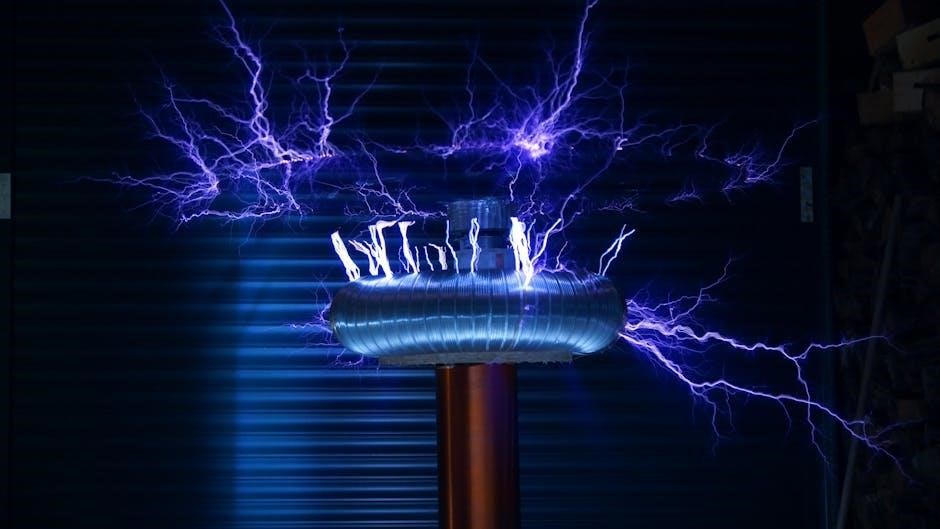Apache Spark, created at UC Berkeley, has evolved into a critical engine for big data processing, powering global organizations. Spark: The Definitive Guide provides comprehensive insights into its capabilities, deployment, and maintenance, authored by its creators, Bill Chambers and Matei Zaharia.
History and Evolution of Apache Spark
Apache Spark originated in 2009 as a research project at UC Berkeley, led by Matei Zaharia, Mosharaf Chowdhury, Michael Franklin, Scott Shenker, and Ion Stoica. Initially published in a paper titled Spark: Cluster Computing with Working Sets, it aimed to address the limitations of Hadoop MapReduce by introducing in-memory computation. Spark was designed to handle large-scale data processing more efficiently, supporting both batch and real-time workloads. Over the years, Spark evolved into a unified engine for big data processing, incorporating key features like DataFrames, Datasets, and Structured Streaming. The release of Spark 2.0 marked a significant milestone, solidifying its role in the Open Lakehouse Architecture. Today, Spark is a cornerstone of modern data processing, powering thousands of organizations worldwide.
Key Features of Apache Spark
Apache Spark is a unified computing engine known for its speed, versatility, and ease of use. Its in-memory processing capability makes it significantly faster than traditional disk-based systems like Hadoop MapReduce. Spark supports a wide range of workloads, including batch processing, interactive queries, real-time streaming, and machine learning. It offers high-level APIs in languages like Scala, Python, Java, and R, making it accessible to a broad audience of developers. Spark’s scalability allows it to handle massive datasets across clusters of machines efficiently. Additionally, it provides built-in libraries for SQL, machine learning, and graph processing, enabling comprehensive data processing. These features, combined with its fault-tolerant design, make Spark a powerful tool for modern data-driven applications. Spark: The Definitive Guide dives deeper into these capabilities, offering practical insights for users.
Use Cases for Apache Spark
Apache Spark is widely used for diverse big data processing tasks, making it a versatile tool for modern applications. It excels in data engineering, enabling efficient ETL (Extract, Transform, Load) operations and data integration. Spark is also a cornerstone for data science, supporting interactive queries and exploratory analysis. Its machine learning library, MLlib, powers predictive modeling and advanced analytics. Additionally, Spark is ideal for real-time processing, with Structured Streaming enabling fault-tolerant and scalable stream processing. Organizations leverage Spark for applications like log analysis, fraud detection, and IoT data processing. Its ability to handle batch and streaming data seamlessly makes it a critical component in data-driven architectures. Spark: The Definitive Guide highlights these use cases, providing insights into how Spark addresses real-world challenges effectively. Its versatility and performance make it a cornerstone for modern data processing needs across industries.

Core Concepts of Apache Spark
Apache Spark is a unified computing engine with libraries for SQL, streaming, and machine learning. It offers scalability, speed, and ease of use, making it a powerful tool for big data tasks.
Resilient Distributed Datasets (RDDs)
Resilient Distributed Datasets (RDDs) are a fundamental concept in Apache Spark, representing an immutable collection of objects distributed across nodes in a cluster. They are the basic programming abstraction in Spark, enabling parallel operations on large datasets. RDDs are partitioned across machines, allowing efficient processing and recovery in case of node failures. Fault tolerance is achieved through lineage, where Spark rebuilds lost data by retracing the operations used to create it. RDDs support two types of operations: actions, which produce results, and transformations, which create new datasets. While RDDs provide flexibility, they are less optimized than DataFrames and Datasets, which were introduced in later Spark versions for structured data processing. RDDs remain essential for understanding Spark’s core functionality and are often used for unstructured or semi-structured data.
DataFrames and Datasets
DataFrames and Datasets are high-level APIs in Apache Spark, introduced to enhance data processing efficiency and simplify operations. DataFrames, introduced in Spark 1.3, provide a schema-aware, tabular data structure, similar to a relational database table, allowing for optimized queries. Datasets, introduced in Spark 2.0, extend DataFrames by adding type-safe, object-oriented APIs, enabling compile-time type checking for better code reliability. Both support a wide range of data formats, including JSON, CSV, and Parquet, and can be manipulated using SQL queries or programming languages like Scala, Python, and Java. DataFrames are ideal for structured and semi-structured data, while Datasets are suited for complex, typed data operations. These APIs leverage Spark’s Catalyst optimizer and whole-stage code generation, ensuring efficient execution plans. Their scalability and fault tolerance make them indispensable for large-scale data processing tasks, offering a balance between performance and ease of use.
Spark SQL and Its Importance
Spark SQL is a key module in Apache Spark, enabling users to work with structured and semi-structured data using SQL or DataFrame APIs. It provides a high-level abstraction for data manipulation, making it accessible to both SQL experts and programming language users. Spark SQL supports various data formats, including JSON, Parquet, and Avro, and integrates seamlessly with external data sources. Its importance lies in its ability to simplify complex data processing tasks, leveraging Spark’s distributed computing capabilities. Spark SQL also plays a central role in the Open Lakehouse Architecture, offering features like schema management and governance.
Spark SQL’s DataFrame API allows for efficient data manipulation and analysis, while its Catalyst optimizer ensures high-performance query execution. It bridges the gap between relational databases and big data processing, making it a cornerstone of Spark’s ecosystem for data engineers and scientists.
Structured Streaming in Spark
Structured Streaming in Spark is a scalable and fault-tolerant stream processing engine built on the Spark SQL engine. It allows users to express streaming computations using the same DataFrame/Dataset API used for batch data, enabling seamless integration between batch and streaming workloads. The engine incrementally processes data and updates results as new streams arrive, providing real-time insights without requiring custom streaming logic.
Structured Streaming supports two processing modes: micro-batch and continuous. Micro-batch achieves low-latency and exactly-once guarantees, while continuous processing offers millisecond-level latency with at-least-once guarantees. It also ensures fault tolerance through checkpointing and Write-Ahead Logs, making it reliable for mission-critical applications. This feature is detailed in Spark: The Definitive Guide, highlighting its role in modern data processing pipelines.

Apache Spark Ecosystem
Apache Spark’s ecosystem offers a unified engine for diverse data processing workloads. Spark: The Definitive Guide provides insights into its architecture, deployment, and integration for scalable solutions.
Spark Core and Its Components
Spark Core serves as the foundation of Apache Spark, enabling task scheduling, resource management, and efficient data processing across clusters. It handles the fundamental operations, ensuring scalability and fault tolerance. The Core component integrates seamlessly with Spark SQL, DataFrames, and Structured Streaming, maintaining compatibility and consistency across the ecosystem. It supports Resilient Distributed Datasets (RDDs), which are immutable collections of objects split across nodes for parallel processing. Spark: The Definitive Guide highlights how Spark Core optimizes performance by minimizing data serialization and leveraging in-memory caching. This layer ensures that distributed operations are executed efficiently, making it the backbone of Spark’s functionality. The book provides detailed insights into how Spark Core interacts with other components, ensuring a unified and high-performance computing framework.
Spark RDD Programming
Spark RDD Programming introduces Resilient Distributed Datasets (RDDs), a fundamental abstraction in Apache Spark. RDDs represent immutable collections of objects that can be split across multiple nodes for parallel processing. They are the building blocks for Spark’s core functionality, enabling tasks like data aggregation, filtering, and mapping. Spark: The Definitive Guide explains how RDDs support both in-memory and disk-based storage, ensuring fault tolerance and efficient data recovery. RDD operations are divided into transformations, which create new datasets, and actions, which return results to the driver. Examples of transformations include map and filter, while actions like reduce and count execute computations. RDDs also support caching, allowing datasets to be stored in memory for faster access. This programming model is essential for understanding Spark’s distributed computing paradigm.
Spark DataFrames and SQL
Spark DataFrames and SQL provide a high-level abstraction for structured and semi-structured data processing. Introduced in Spark 1.3, DataFrames extend RDDs by adding schema information, enabling efficient data manipulation. They support various data formats like JSON, Parquet, and Avro. Spark: The Definitive Guide details how DataFrames improve performance through schema-aware optimizations. Spark SQL allows SQL queries on DataFrames, making it accessible to analysts. Key DataFrame operations include filter, groupBy, and join. The Catalyst optimizer and Tungsten execution engine enhance performance. DataFrames also integrate with external data sources and Hive metastores. This structured approach simplifies complex data processing, making Spark SQL a powerful tool for data engineers and analysts.
Spark Structured Streaming
Spark Structured Streaming is a scalable and fault-tolerant stream processing engine built on the Spark SQL engine. It allows users to express streaming computations similarly to batch processing on static data. The Spark SQL engine handles incremental execution, updating results continuously as new data arrives. Structured Streaming supports Dataset and DataFrame APIs in Scala, Java, Python, and R for operations like streaming aggregations and event-time windows. By default, it uses micro-batch processing, achieving latencies as low as 100 milliseconds with exactly-once guarantees; Since Spark 2.3, Continuous Processing mode offers sub-millisecond latencies with at-least-once guarantees. The system ensures fault tolerance through checkpointing and Write-Ahead Logs. This feature simplifies real-time data processing, making it accessible without deep streaming expertise, as detailed in Spark: The Definitive Guide.

Advanced Topics in Apache Spark
Advanced topics in Apache Spark include performance tuning, cluster management, and security measures. These optimizations ensure efficient processing and scalable deployments, as detailed in Spark: The Definitive Guide.
Spark Performance Tuning
Spark performance tuning is crucial for optimizing big data processing. By leveraging in-memory caching, parallel processing, and efficient resource allocation, users can significantly enhance job execution speed. Spark: The Definitive Guide highlights strategies like tuning partition sizes, optimizing join operations, and managing memory usage to avoid spills. The book also emphasizes the importance of understanding execution plans and leveraging tools like the Spark UI for monitoring. Advanced techniques such as predicate pushdown and columnar storage can further accelerate queries. Additionally, configuring parameters like `spark.executor.memory` and `spark.default.parallelism` can tailor performance to specific workloads. By applying these best practices, developers can unlock Spark’s full potential for scalable and efficient data processing, ensuring optimal performance in both batch and streaming scenarios.
Spark Cluster Management
Spark cluster management is essential for efficiently managing distributed computing resources. Apache Spark supports various cluster managers like Apache Mesos, Hadoop YARN, and Spark Standalone, each offering distinct resource allocation and task scheduling capabilities. These managers handle node provisioning, resource allocation, and job scheduling, ensuring optimal utilization of cluster resources. Spark: The Definitive Guide provides insights into configuring and managing clusters for scalability and fault tolerance. It also covers best practices for monitoring cluster performance and troubleshooting common issues. By leveraging these strategies, organizations can effectively manage their Spark deployments, ensuring high availability and efficient processing of large-scale data workloads. The guide emphasizes the importance of understanding cluster management to maximize Spark’s potential in distributed environments.
Spark Security and Governance

Apache Spark provides robust security features to protect sensitive data and ensure governance in distributed environments. Encryption is supported for data at rest and in transit, while authentication mechanisms like Kerberos and LDAP ensure secure access. Authorization controls, such as role-based access control (RBAC), allow fine-grained permissions for data and operations. Spark: The Definitive Guide highlights these security measures and best practices for implementing them effectively. Additionally, Spark integrates with governance frameworks to maintain data lineage and compliance, ensuring accountability and auditability. By adhering to these security and governance practices, organizations can securely manage their Spark deployments and maintain regulatory compliance while processing large-scale data workloads.
Spark Integration with Other Tools
Apache Spark seamlessly integrates with a wide range of tools and technologies, enhancing its versatility in big data ecosystems. It works alongside libraries like MLlib for machine learning and GraphX for graph processing, while also supporting connectors for data sources such as Hadoop, Kafka, and cloud storage systems. Spark: The Definitive Guide emphasizes its compatibility with modern data architectures, including the Open Lakehouse Architecture, where Spark complements tools like Delta Lake and Iceberg for governed data storage. Additionally, Spark integrates with popular data engineering and analytics platforms, such as AWS, Azure, and Databricks, enabling scalable and efficient data processing workflows. This adaptability ensures Spark remains a cornerstone in diverse data-driven environments, from real-time streaming to batch processing and advanced analytics.

Apache Spark APIs
Apache Spark offers APIs in Scala, Python, Java, and R, enabling efficient data processing and unified analytics. These APIs streamline development across diverse programming languages and use cases.
Spark Scala API
The Spark Scala API is the foundation of Apache Spark, providing direct access to its core functionalities. As Spark is built in Scala, this API offers native integration with Scala’s language features, including type safety and lambda functions. It allows developers to work with Resilient Distributed Datasets (RDDs), enabling low-level data manipulation and parallel operations. The Scala API is often used for complex data processing tasks and is considered the primary interface for Spark’s ecosystem. With its concise syntax and powerful abstractions, it simplifies distributed computing, making it a preferred choice for experienced developers. This API is extensively covered in Spark: The Definitive Guide, providing detailed examples and best practices for leveraging its capabilities effectively.
Spark Python API (PySpark)
PySpark is Apache Spark’s Python API, designed to bring Spark’s powerful capabilities to Python developers. It provides an intuitive interface for processing large-scale data, making Spark accessible to a broader audience. PySpark supports key Spark concepts like RDDs, DataFrames, and Datasets, allowing Python users to leverage Spark’s distributed computing model. Its simplicity and ease of use make it a popular choice for data science and engineering tasks. PySpark also integrates seamlessly with Python’s extensive libraries, such as NumPy and pandas, enhancing data manipulation and analysis workflows. Spark: The Definitive Guide includes detailed examples and best practices for using PySpark effectively, ensuring developers can maximize Spark’s potential in Python environments.
Spark Java API
The Spark Java API provides a robust interface for Java developers to interact with Apache Spark. Designed to leverage Java’s ecosystem, it allows developers to create and manipulate RDDs, DataFrames, and Datasets seamlessly. The API is compatible with Java 8 and later versions, ensuring accessibility for a wide range of applications. It mirrors Spark’s Scala API closely, enabling Java developers to benefit from Spark’s powerful distributed computing capabilities. The Java API also supports Spark SQL, enabling users to write SQL queries and analyze data effectively. With its intuitive syntax and integration with Java libraries, the Spark Java API is a versatile tool for building scalable data processing applications. Spark: The Definitive Guide offers detailed insights and examples for mastering the Java API, making it an essential resource for developers.
Spark R API
The Spark R API is a powerful interface designed for R programmers, enabling them to leverage Apache Spark’s capabilities for large-scale data processing. It allows users to work with Spark’s distributed datasets, DataFrames, and machine learning algorithms directly from R. The API supports popular R data structures and integrates seamlessly with Spark SQL, making it ideal for data scientists and analysts. Spark: The Definitive Guide highlights how the R API simplifies the transition to distributed computing, offering examples for data manipulation, visualization, and modeling. It also covers how to use R with Spark’s machine learning library, MLlib. This integration makes Spark accessible to R users, enabling them to scale their workflows efficiently. The Spark R API is a valuable tool for combining R’s statistical capabilities with Spark’s distributed computing power, making it a cornerstone for data-driven applications.

Apache Spark in Real-World Applications
Apache Spark powers diverse applications, from data engineering and machine learning to real-time processing. Spark: The Definitive Guide showcases its versatility, enabling organizations to scale and innovate efficiently across industries.
Spark for Data Engineering
Apache Spark is a cornerstone for modern data engineering, enabling efficient ETL processes, data transformation, and aggregation. Spark: The Definitive Guide highlights its role in building scalable data pipelines, leveraging in-memory processing for faster operations. With support for batch and real-time data, Spark empowers engineers to handle massive datasets seamlessly. Its integration with tools like Apache Kafka and Hadoop Distributed File System (HDFS) makes it ideal for constructing data lakes and lakehouses. The guide emphasizes Spark’s ability to process structured, semi-structured, and unstructured data, making it a versatile tool for data engineers. By providing high-level APIs and SQL support, Spark simplifies complex data engineering tasks, ensuring scalability and performance for modern data architectures.

Spark for Data Science

Apache Spark is a powerful tool for data science, enabling efficient processing of large-scale datasets for scientific analysis. Spark: The Definitive Guide emphasizes its role in facilitating iterative algorithms and machine learning workflows. With libraries like MLlib, Spark provides robust tools for tasks such as clustering, classification, and dimensionality reduction. Its ability to handle both batch and real-time data makes it ideal for exploratory data analysis and model training. The guide highlights Spark’s integration with popular data science languages like Python and R, allowing seamless interaction with libraries such as NumPy and pandas. Spark’s scalability ensures that data scientists can work efficiently with massive datasets, while its APIs simplify complex operations. By supporting end-to-end data science workflows, from data ingestion to model deployment, Spark has become a cornerstone in modern data science ecosystems.
Spark for Machine Learning
Apache Spark is a robust framework for machine learning, offering scalable tools to train and deploy models on large datasets. The Spark: The Definitive Guide highlights MLlib, Spark’s built-in machine learning library, which provides efficient algorithms for classification, regression, clustering, and more. Spark’s ability to process data in-memory accelerates iterative algorithms, making it ideal for tasks like gradient descent. The guide also explores Spark’s integration with popular machine learning tools like TensorFlow and PyTorch, enabling seamless model development. Additionally, Spark’s support for real-time data processing allows for continuous model updates and predictions; With its scalability and versatility, Spark empowers data scientists to build and deploy machine learning models efficiently, catering to both batch and streaming workflows. This makes Spark a cornerstone in modern machine learning ecosystems, bridging the gap between data processing and model implementation.
Spark for Real-Time Processing
Apache Spark excels in real-time processing, enabling organizations to act on data as it arrives. The Spark: The Definitive Guide details Structured Streaming, a scalable and fault-tolerant engine for real-time data. It allows users to express streaming computations similarly to batch queries, leveraging the Spark SQL engine for efficiency. By default, Structured Streaming uses micro-batch processing, achieving low latency and exactly-once guarantees through checkpointing. Since Spark 2.3, Continuous Processing mode offers even lower latency, down to 1 millisecond, with at-least-once guarantees. These modes ensure flexibility for diverse applications. Spark’s real-time capabilities are enhanced by its integration with tools like Kafka and Kinesis, making it a powerful choice for applications requiring immediate insights, such as fraud detection, IoT analytics, and live dashboards. This makes Spark indispensable for organizations needing to process and act on data in real time.

Learning and Resources
Apache Spark learning resources include Spark: The Definitive Guide by Zaharia and Chambers, community forums, training programs, and official documentation, aiding developers and engineers.
Spark Documentation and Guides
Apache Spark’s official documentation provides detailed guides for developers, covering APIs, configurations, and best practices. Spark: The Definitive Guide by Bill Chambers and Matei Zaharia offers a comprehensive overview, exploring Spark’s core concepts, deployment strategies, and advanced features. The book is divided into sections, each focusing on specific aspects of Spark, such as DataFrames, Structured Streaming, and performance tuning. Additionally, the Structured Streaming Programming Guide explains how to handle real-time data processing using Spark SQL. The official Spark website also hosts extensive resources, including API references and community-contributed tutorials. For hands-on learners, the central repository for Spark: The Definitive Guide provides accompanying materials, examples, and code snippets. These resources collectively empower developers to master Spark, from basic operations to complex big data applications.
Spark Community and Forums
The Apache Spark community is vibrant and collaborative, with thousands of contributors worldwide. Forums like the Apache Spark mailing list and Stack Overflow foster knowledge sharing and problem-solving among developers. The community-driven ecosystem encourages open dialogue, ensuring users can troubleshoot and innovate together. Spark Summits, organized by Databricks, bring together experts and enthusiasts to discuss advancements and use cases. Regional user groups and meetups provide localized support, making Spark accessible globally. These platforms, along with Spark: The Definitive Guide, empower developers to leverage Spark’s capabilities effectively, ensuring a strong support network for both newcomers and experienced professionals. The community’s collective efforts continue to enhance Spark’s functionality and adoption across industries.
Spark Training and Certification
Apache Spark offers extensive training and certification programs to help professionals master its capabilities. Courses are available globally, including instructor-led sessions in cities like Cardiff, catering to corporate, government, and individual learners. These programs cover deployment, maintenance, and advanced features, ensuring hands-on experience. For self-paced learning, resources like Spark: The Definitive Guide provide detailed insights, written by Spark’s creators. Certifications validate expertise, making professionals more competitive in the job market. Training materials often include real-world examples and exercises, aligning with industry demands. Whether through structured courses or self-study, Spark’s educational ecosystem equips users with the skills needed to leverage its powerful tools effectively. These resources ensure a strong foundation for both beginners and experienced practitioners aiming to advance their careers in big data processing.
Spark Books and Tutorials
Spark: The Definitive Guide by Bill Chambers and Matei Zaharia is a comprehensive resource for learning Apache Spark. This book provides in-depth insights into Spark’s capabilities, including deployment, maintenance, and advanced features. It is structured into distinct sections, each focusing on specific aspects of Spark, such as Spark SQL, DataFrames, and Structured Streaming. The guide includes practical examples in SQL, Python, and Scala, making it accessible to both beginners and experienced practitioners. Available on platforms like Amazon, this book is widely regarded as the go-to resource for mastering Spark. Additionally, the structured streaming section offers detailed explanations, enabling users to process real-time data effectively. Whether you’re looking to deepen your understanding or gain hands-on experience, this guide is an essential companion for anyone working with Apache Spark.
